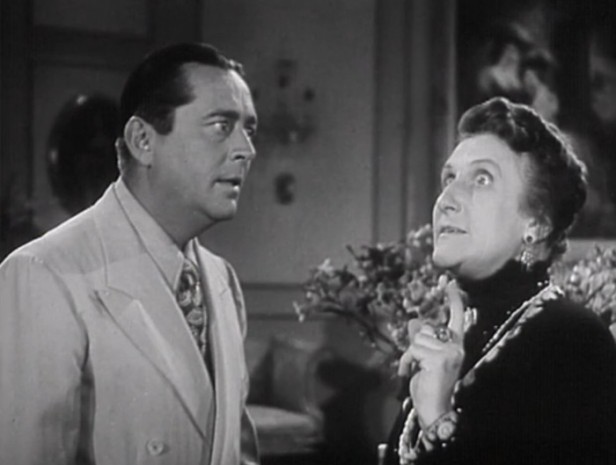The oxymoronic title should be a clue here really. The Living Ghost is a would-be comedy chiller in which most of the jokes fall flat and which flirts ineffectively with standard old dark house eeriness and a vaguely horror-tinged mystery gimmick. It was the work of the infamous William Beaudine, a director who specialised in shooting fast and cheap, though he was more professional than the nickname afforded him by the odious Medved Brothers – “One-Shot” Beaudine – might suggest. In cahoots with writer Joseph Hoffman – working from an original story titled Money for What by Howard Dimsdale – he makes a film that’s more coherent than a lot of the genre films we come to be familiar with from producers Monogram, but that’s not to say that it’s any good. Far from it in fact and it’s that dreadful humour that manages to kill it stone dead.
the story in paper thin. Banker Walter Craig (Gus Glassmire) has vanished, and his friend Ed Moline (Paul McVey) calls on the services of former private eye Nick Trayne (James Dunn), who now ekes out a living as a “listening ear,” a sort of “agony aunt.” Initially reluctant to take the case, Trayne eventually accepts the challenge and arrives at the family estate where Craig’s second wife Helen (Edna Johnson), his daughter Tina (Jan Wiley), her fiancé Arthur Wallace (Howard Banks), Craig’s sister Delia Phillips (Minerva Urecal), her husband George (J. Arthur Young), Craig’s former business partner Tony Weldon (George Eldredge), his secretary Billie Hilton (Joan Woodbury), and Cedric the butler (Norman Willis) have all gathered. Craig turns up in the middle of the night, alive but catatonic, in a zombie-like trance (he’s the “living ghost” of the title) – but where has he been, who caused his current state and who is killing off his family members and guests?

There’s a minor science fiction McGuffin, an experimental machine that has somehow affected Craig’s brain cells and a bickering romance forming between Nick and Billie but none of it is enough to really make you care about the characters or their situations. The title promises more spookiness than it actually delivers – it was retitled Lend Me Your Ear and The Walking Nightmare in the UK – and as a genre film it’s decidedly minor, borderline science fiction at best and barely horror at all. It must have seemed old hat even at the time which might explain why Hoffman feels the need to pad a very weak storyline with some truly terrible humour – an opening scene features a client of Trayne’s (Danny Beck) who talks gibberish in a most unamusing way who has no impact whatsoever on the actual plot and who promptly gets written out as soon as he’s finished his routine.
And the whole film’s like that, a mishmash of half-baked ideas, rudimentary mystery, mostly dreadful jokes (though Trayne wondering ” Why must there be a butler in every murder mystery?” raises a smile) and a romance that feels bolted on from another script. The funniest moments come not from Hoffman’s script but from some hilariously mismatched musical cues that seem to have been chosen precisely because they’re just so inappropriate for what’s happening on screen.

The romance would have worked better had Trayne not been such an aggravating character, constantly wisecracking and but not terribly well and deploying a chat up technique that must have seemed positively Neanderthal even then. Quite what the rather likable Billie sees in the boorish old misogynist isn’t at all clear. She’s played rather well by Woodbury, bringing a charm and energy to an absolutely nothing role and she goes some way to making up for the annoying Dunn. It’s hard to believe that this is the same actor who, three years later, would take home the Best Supporting Actor Oscar for his lovely turn in Elia Kazan’s debut film as director, A Tree Grows in Brooklyn (1945). He wasn’t helped one iota by Hoffman who, one suspects, was going for a The Thin Man (1934) feel without actually understanding what it was that made the film and its sequels After the Thin Man (1936), Another Thin Man (1939) and Shadow of the Thin Man (1941) so successful (two more Thin Man films were released after The Living Ghost, The Thin Man Goes Home (1945) and Song of the Thin Man (1947)).
Some contemporary critics seemed to enjoy The Living Ghost‘s humour, but it hasn’t aged at all well and today The Living Ghost is just another Poverty Row cheapie, probably serviceable enough as a B-feature in 1942 but looking very dull and under-achieving today. But it was good enough for Monogram, and Beaudine, already a regular fixture at the company, would become their most prolific director. That legendary speed and thriftiness kept him in gainful employ at their Sunset Drive studios where he skipped from genre to genre but seemed most at home in comedy, working particularly closely with the Bowery Boys troupe, more than capable of turning out a film in less than a week. The Living Ghost makes a tad more sense than most of his work for the Poverty Row crowd (he also worked for Producers Releasing Corporation (PRC) and even came to the UK in the 1930s to make films with comedians Will Hay and George Formby) but it’s instantly disposable and far less well remembered today than some of his more full-blooded, but not much better, genre fare (The Ape Man (1943), Voodoo Man (1944), The Feathered Serpent (1948), Jesse James Meets Frankenstein’s Daughter (1966) et al).
I’ll have to look this one up. I’ve seen the name numerous times. My personal favorite comedy-mystery set in a mansion is 1942’s The Hidden Hand with Craig Stevens (TV’s Peter Gunn) and the great portrayer of creeps, Milton Parsons, as a homicidal maniac.
LikeLiked by 2 people
Not seen that one – I’ll seek it out!
LikeLiked by 1 person